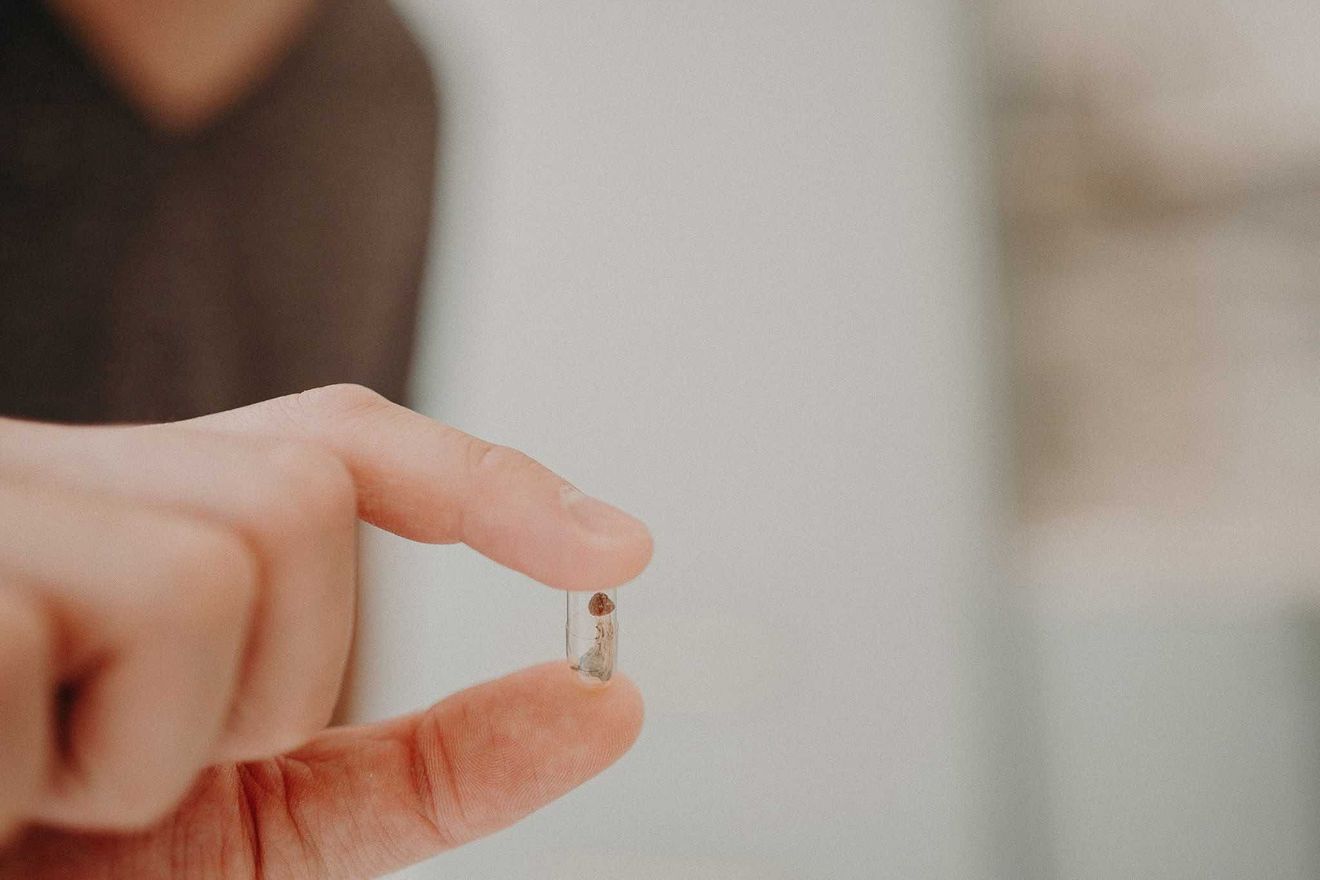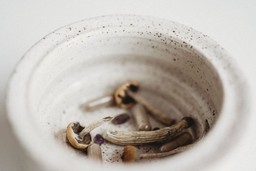There are many proposed remedies for mental health concerns, such as meditation, therapy, and prescription medications. The most recent trend offered as a way to improve mental well-being is microdosing.
What was once a taboo practice is slowly becoming more accepted because it can decrease anxiety, improve performance, and support well-being. So what is microdosing, and how does it work? Here are the basics.
What is Microdosing?
Microdosing is when a person takes tiny doses of a specific drug, often classical psychedelic substances. The amount taken is less than a full or therapeutic dose recommendation. In most cases, it’s between 5 and 10 percent of a standard dose taken a few to several times a week. Usually, these low doses mean the amount is sub-hallucinogenic. Therefore, it typically won’t cause altered states of consciousness or possible side effects experienced with a complete dose of psychedelics.
Follow your Curiosity
Sign up to receive our free psychedelic courses, 45 page eBook, and special offers delivered to your inbox.The History of Psychedelics and Dosing
Psychedelics are most strongly associated with non-ordinary states of consciousness, “trips,” and magical experiences. Substances such as LSD and magic mushrooms have made their way into mainstream conversation due to the intense psychological experiences they elicit. However, scientists have long wondered if these drugs could do more than just be used for recreational purposes. They asked if they might be able to treat psychiatric conditions.
Starting around the 1950s, patients with known mental health disorders were given psychedelics as part of experiments. Then, doctors gave these patients full doses of psychedelic drugs.
Full-dose side effects of psychedelics can be positive and negative. Adverse side effects include a challenging experience (a “bad trip”), physiological discomfort, anxiety, and delayed onset headaches. However, positive side effects were reported, too, such as relief of anxiety, PTSD, and depression. While experts once researched the benefits of full-dose psychedelics, much ended after such substances were prohibited.
Today, the same substances are used in sub-hallucinogenic doses to try and elicit similar benefits without adverse side effects. For example, two trials reported decreased anxiety and improved mood in patients being micro-dosed with two psychedelic substances.
What Substances are used for Microdosing?
Most drugs used in microdosing won’t be purchased over the counter or prescribed by your family doctor.
Substances can include:
- Psilocybin is a species of mushroom referred to as “magic mushrooms.”
- Lysergic acid diethylamide, better known as LSD
- Cannabis
- Ayahuasca
- 3,4-methylenedioxyamphetamine (MDMA)
- Mescaline, found in some cacti such as peyote or san pedro
- N, N-dimethyltryptamine (DMT)
You’ll notice that many of these drugs often have a negative connotation, classified as Schedule I drugs by the U.S. Drug Enforcement Administration (DEA) as drugs likely to be abused. This classification results from these drugs being so potent that they pose a high risk of addiction, making microdosing legally tricky to navigate. Many states prohibit the use and sale of these drugs. Additionally, depending on how you obtain these unregulated drugs, you may not be guaranteed the correct dosage or potency.
How Microdosing Works
Psychedelics affect serotonin, a chemical messenger. It assists in the communication between nerve cells and other cells in your body. It is associated with mood, sleep, hunger and thirst cues, cognition, memory, and thermoregulation. Your central nervous system contains serotonin 2A receptors which can be triggered or blocked by certain chemicals. Psychedelics seem to target these receptors.
Scientists aren’t exactly sure of the relationship between psychedelics and serotonin reactors. One theory is that when the drug binds to the receptor, your brain becomes excitable, which is why high doses can trigger hallucinations. Substances may also increase your neuroplasticity, causing your neural networks to change and grow more connections.
This is often a good thing, allowing you to learn, change, and adapt. Psychedelics may also help to reduce inflammation. Chronic inflammation is a symptom of various health conditions, including mental disorders like depression. Scientists believe microdosing could elicit some potentially beneficial side effects without the hallucinations.
Possible Benefits of Microdosing
Recent clinical trials have shed light on some of the possible benefits of microdosing. Studies are currently testing if microdosing could be a treatment option for mental health conditions.
Benefits experienced after microdosing can include:
- Increased creativity
- Higher energy
- Improved mood
- Lower anxiety and depression
- Better concentration
- Higher self-efficacy
- Improved mental clarity
- Improved socialization
- Better sleep
- Fewer migraines
One study found that microdosing helped to improve patients’ mental health, according to self-reported perspectives. Patients indicated that they had increased productivity and creativity along with decreased depression and anxiety. However, these results were self-reported.
Animal studies have shown that microdosed rats with DMT had similar physiological and physical responses to those given antidepressants. They also seemed to have improved optimism and resilience with less anxiety.
However, it is essential to note that in some of these studies, participants who had a placebo also reported these effects, making it difficult for researchers to determine if the reported benefits are from microdosing.
Potential Adverse Side Effects of Microdosing
As the drugs used in microdosing are unregulated and often illegal psychedelics, there are some potential drawbacks.
Some individuals may be more susceptible to adverse side effects. For example, the potency of the dose could trigger mental health issues or psychotic episodes in those with conditions that put them at risk for psychosis, such as schizophrenia.
Other undesirable side effects include:
- Trouble sleeping
- Impaired focus
- Drained energy
- Migraines
- Over-stimulation
- Anxiety
- Physical discomfort
Studies have not been able to pinpoint relationships between these side effects and the type of psychedelic or specific dose.
It’s important to note that because microdosing usually isn’t a prescribed regimen, most people do not take a set dosage on a specific schedule. Many individuals who microdose may take just enough to feel the positive effects, which can vary from day to day and substance to substance. Taking too much could elicit psychedelic experiences or even the “bad trip” side effects experienced with a full dose of psychedelics. Those who microdose regularly could also build up a tolerance to the substance over time, risking dependence.
The Bottom Line
Microdosing is when an individual ingests a small percentage of a full drug dose. Often, the drug is psychedelic, such as LSD or psilocybin. In higher doses, psychedelics can produce both positive and negative effects. Microdosing may elicit the benefits of psychedelics without the shifts in consciousness. However, research is minimal, and experts have not been able to conclude the risks, benefits, and side effects of microdosing for any one substance.
Furthermore, most psychedelic substances are illegal, making microdosing tricky for most individuals. The drugs typically must be illegally obtained and are unregulated, meaning the drug’s contents and dosage is not verified. Though microdosing is rising in popularity, many factors can make it risky. Speaking to a healthcare provider or mental health professional before starting a microdosing regimen is essential.
Follow your Curiosity
Sign up to receive our free psychedelic courses, 45 page eBook, and special offers delivered to your inbox.References
- Goodwin GM, Aaronson ST, Alvarez O, et al. Single-dose psilocybin for a treatment-resistant episode of major depression. New England Journal of Medicine. 2022;387(18):1637-1648. https://www.nejm.org/doi/full/10.1056/NEJMoa2206443
- Anderson T, Petranker R, Christopher A, et al. Psychedelic microdosing benefits and challenges: an empirical codebook. Harm Reduction Journal. 2019;16(1):43. https://harmreductionjournal.biomedcentral.com/articles/10.1186/s12954-019-0308-4
- Prochazkova L, Lippert DP, Colzato LS, Kuchar M, Sjoerds Z, Hommel B. Exploring the effect of microdosing psychedelics on creativity in an open-label natural setting. bioRxiv. Published online August 11, 2018:384412. https://www.biorxiv.org/content/10.1101/384412v2
- Lord LD, Expert P, Atasoy S, et al. Altered trajectories in the dynamical repertoire of functional network states under psilocybin. bioRxiv. Published online July 25, 2018:376491. https://www.biorxiv.org/content/10.1101/376491v1
- Polito V, Stevenson RJ. A systematic study of microdosing psychedelics. PLoS One. 2019;14(2):e0211023. https://www.ncbi.nlm.nih.gov/pmc/articles/PMC6364961/
- Rootman JM, Kryskow P, Harvey K, et al. Adults who microdose psychedelics report health related motivations and lower levels of anxiety and depression compared to non-microdosers. Sci Rep. 2021;11(1):22479. https://www.nature.com/articles/s41598-021-01811-4
- Kuypers KP, Ng L, Erritzoe D, et al. Microdosing psychedelics: More questions than answers? An overview and suggestions for future research. J Psychopharmacol. 2019;33(9):1039-1057. https://journals.sagepub.com/doi/full/10.1177/0269881119857204
- Rootman JM, Kiraga M, Kryskow P, et al. Psilocybin microdosers demonstrate greater observed improvements in mood and mental health at one month relative to non-microdosing controls. Sci Rep. 2022;12(1):11091. https://www.nature.com/articles/s41598-022-14512-3
- Hartong V, Emmerik A van. Psychedelic microdosing, mindfulness, and anxiety: a cross-sectional mediation study. Journal of Psychoactive Drugs. 2022;0(0):1-11. https://www.tandfonline.com/doi/full/10.1080/02791072.2022.2080616
- Cover image credit Mush Stock








